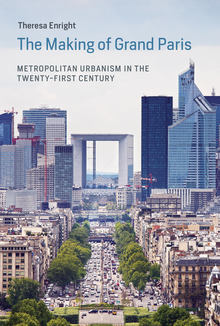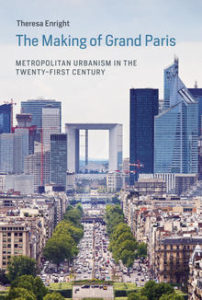
The Making of Grand Paris: Metropolitan Urbanism in the Twenty-First Century by Theresa Enright
 On May 25, 2017, the French newspaper Le Monde carried the headline “Grand Paris: The building site of the century is launched” in reference to the preliminary steps that had been taken to construct the new train station of Fort-d’Issy-Vanves-Clamart, which is part of the Grand Paris project. Seven years after a decision was made to create four new metro lines for the Paris metropolitan area, the project envisioned the construction of 200 kilometers of tunnels and sixty-eight stations, of which two thirds would be linked to existing metro lines, in the space of 10 to 15 years. The president of the Société du Grand Paris, Philippe Yvin, who is responsible for overseeing the project, summarized the construction of a new transportation infrastructure by asserting that the Paris project was “twice as important as Crossrail in London” and “the fourth in the world behind projects in China and India.” The larger goal of the Grand Paris project was to create a new kind of city. It was announced in 2007 by then president Nicolas Sarkozy, and involved the coordinated effort of the French state, the city of Paris, the Regional Council of the Ile-de-France, and the Ile-de-France’s mayoral association. This book is primarily concerned with how the project was formulated in its initial stages, between 2007 and 2014, and the implications of the implementation of such a project for Paris and for “global metropolitan futures” (3).
On May 25, 2017, the French newspaper Le Monde carried the headline “Grand Paris: The building site of the century is launched” in reference to the preliminary steps that had been taken to construct the new train station of Fort-d’Issy-Vanves-Clamart, which is part of the Grand Paris project. Seven years after a decision was made to create four new metro lines for the Paris metropolitan area, the project envisioned the construction of 200 kilometers of tunnels and sixty-eight stations, of which two thirds would be linked to existing metro lines, in the space of 10 to 15 years. The president of the Société du Grand Paris, Philippe Yvin, who is responsible for overseeing the project, summarized the construction of a new transportation infrastructure by asserting that the Paris project was “twice as important as Crossrail in London” and “the fourth in the world behind projects in China and India.” The larger goal of the Grand Paris project was to create a new kind of city. It was announced in 2007 by then president Nicolas Sarkozy, and involved the coordinated effort of the French state, the city of Paris, the Regional Council of the Ile-de-France, and the Ile-de-France’s mayoral association. This book is primarily concerned with how the project was formulated in its initial stages, between 2007 and 2014, and the implications of the implementation of such a project for Paris and for “global metropolitan futures” (3).
The Making of Grand Paris is divided into three parts. Part 1, “Envisioning the Unified City,” addresses the question of design and a new conception of Paris as a global city. Part II, “Connecting the Networked City,” explores how the city would be connected and navigated by a growing number of the metropolitan area’s inhabitants. Part III, “Governing the Competitive City,” examines how this new global metropolis would be governed. Enright effectively emphasizes that the city of Paris was literally or figuratively walled off from its surrounding areas for centuries for economic, political, and security reasons. Some of the city’s “portes,” or gates, survive, and where they do not they remain embedded in the urban consciousness as names of metro stops, such as the Porte d’Orléans or the Porte de Clignancourt. There have been efforts to integrate the core of the city with its suburbs for over a century. They started out as socialist projects, but they were gradually supplanted by initiatives launched by bureaucrats, architects, and urban planners, such as Henri Prost, whose 1934 plan envisioned more affordable housing, better transportation between Paris and its surrounding suburbs, green spaces, and the protection of significant cultural and heritage sites. While the Prost Plan was approved in 1939, the outbreak of the Second World War led to its abandonment, and the French state focused more on reconstruction after the war in a region that was increasingly marked by larger processes of economic globalization and deindustrialization. By the late 1990s and early 2000s, parts of the banlieue and the postwar housing estates surrounding of Paris had become racialized ghettos and “dangerous neighborhoods” in official and unofficial discourse, which highlighted the gulf between Paris and its banlieue.
Although the emergence of the racialized ghettos of the banlieue has been of enormous significance, Enright never fully explains how or why this occurred in historical terms. Race and immigration are mentioned only in passing, but the impact of decolonization and the racialization of space, which are missing from her analysis, are never addressed as issues that were central to negotiating the relationship between the city and its surrounding areas. (Indeed, both race and decolonization are absent in the book’s index.) The 2005 riots illuminated the plight of the banlieue suffering the consequences of deindustrialization, racial discrimination, and the widespread sense of civic disenfranchisement among youth, and more particularly those who were born in France to immigrants from France’s former colonies.
Nonetheless, Enright argues that it was in the context of the 2005 riots, which first erupted in Clichy-sur-Bois, that Nicolas Sarkozy, who was elected right-wing president of France in 2007, proposed a regional development plan that would become Grand Paris. The project’s primary goal, according to Enright, is to link the core of France’s capital city to its periphery in order to integrate the metropolis more effectively. It initially took the form of an architectural competition, and Enright describes in painstaking detail the vision of the ten teams enlisted by Sarkozy to present proposals. They range from Atelier Christian de Portzamparc to Agence Grumbach et Associés. However, she does not explain how and why Sarkozy came to the view that it was through the built environment that one could address problems of political unrest, economic stagnation, racial tensions, and social fragmentation. Indeed, Enright does not mention that Nicolas Sarkozy was minister of the interior during the 2005 riots. He was unrelenting in his criticism of the rioters, whom he labeled “racaille” (riffraff) and “voyous” (louts), and he appeared to see more effective policing as the solution to the crisis, which he was charged to quell. This leads one to wonder whether the problem of the banlieue was really the driving force behind the Sarkozy’s Grand Paris project and if his initiative was more about other kinds of interests, including real estate speculation and commercial gain. Enright acknowledges that social welfare objectives, which guided earlier efforts to integrate the core of the city with its periphery, were replaced by neoliberal economic goals, but they are not explored in any systematic way. In this book “neoliberalism” in the Parisian context is “a regime of capital accumulation that shifts production away from manufacturing and toward information, service, tourist, cultural and FIRE industries of governance” (17), but surely it is more than that. Further, although the debates about transport are explored in some detail, a far more extensive discussion of the role of the Paris housing crisis in shaping the way in which the Grand Paris project was articulated would have strengthened her overall analysis. One has little sense of what the critics of Grand Paris have or had to say because Enright concentrates almost exclusively on the project itself, relying on policy documents spatial designs, plans, maps, laws, statistics, speeches, and statements. How the broader French public and more particularly those in the banlieue have been affected by and have responded to it remains unclear. Interviews, and especially of those in civil society, would have been useful in this regard.
The problem of “a thousand layers” of metropolitan governance and the challenge that they pose are the subjects of the third part of the book. Enright raises important questions about how the Grand Paris project came to highlight the necessity of acting collectively for redistributive purposes and for establishing what the standards of good governance should be. These questions are yet to be answered, but she emphasizes that the stakes are high and by no means certain, especially in face of powerful financial interests. These shadowy financial interests are never fully in view in this book, however, even though Enright acknowledges that they have invested in to the redevelopment of the built environment and they have profited from property transactions among local and transnational elites, which contributes to further social polarization that the Grand Paris project ostensibly seeks to reverse.
In many ways the Grand Paris project is unmistakably French in its conception because of the central role that the French state has played in its articulation and implementation. It can also be placed in a continuum with previous attempts to redesign the city. In one of the most interesting parts of the book, Enright explores how the Grand Moscow project, which was announced in 2011, was explicitly based on the French experiment. French business has actually invested in projects in Moscow and the mayor of the city has awarded significant contracts to French companies. While it is beyond the scope of Enright’s book, it would be interesting to examine the way in which the French example translates or fails to translate as it crosses national or continental borders in very different political and social contexts.
Grand Paris is still a project in the making, so one is led to wonder if the imaginary walls separating core and periphery will ever come down and if the metropolis of Paris, including its troubled banlieue, will ever be fully integrated. Enright makes the argument that in “symbolic and material ways Paris is functionally integrated with its banlieue” (159), but the 35 kilometer péripherique, which was completed in 1973, still seems to mark the divide, and Parisians living close to it, at the edge of the city, continue to look inwards and not outwards.
Reviewed by Caroline Ford, University of California, Los Angeles
The Making of Grand Paris: Metropolitan Urbanism in the Twenty-First Century
By Theresa Enright
Publisher: The MIT Press
Hardcover / 328 pages / 2016
ISBN: 9780262034692
To read more book reviews, please click here.
Published on February 1, 2018.




